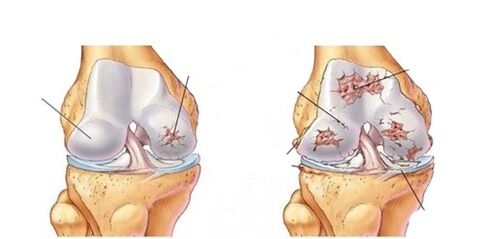Deforming osteoarthritis- a disease associated with degenerative changes (wear) of the cartilage tissue, which lines the articular surfaces of the bones and allows free movement of the limbs.

This is one of the most common pathologies of the musculoskeletal system (the incidence of the adult population in different regions of the Earth ranges between 13 and 29%). Deforming osteoarthritis of the knee joint (gonarthrosis) ranks second in frequency of development, after deforming osteoarthritis of the hip joint.
Causes of knee osteoarthritis.
The mechanism of development of osteoarthritis of the knee is not yet fully understood. However, the factors that contribute to the development of pathology have been known for a long time. Some of them are unavoidable: old age, female sex, hereditary predisposition.
The reasons for the development of deforming arthrosis of the knee joint, which causes accelerated wear and tear of cartilage, include:
- obesity (more than 66% of patients with knee osteoarthritis are overweight);
- pathologies of the musculoskeletal system, which increase the load on the joint (scoliosis, osteochondrosis, flat feet, systemic diseases of the joints, etc. );
- increased physical activity, including sports.
In addition, the progression of gonarthrosis is facilitated by pathologies that disrupt the metabolism of cartilage tissue (endocrine diseases, gout), as well as circulatory diseases (varicose veins of the lower extremities, atherosclerosis of the arteries of the legs, diabetic angiopathy) . Timely and proper therapy of these diseases will help preserve the function of the limb for a long time.
Another common cause of knee osteoarthritis is a knee injury. In such cases, the pathology progresses at an unusually rapid rate. Therefore, we recommend that all patients who have suffered a knee injury be examined in a timely manner and, if necessary, arthroscopy of the knee joint to eliminate intra-articular injuries.
When to see an orthopedic surgeon
An orthopedist-traumatologist should be consulted immediately after the following symptoms of osteoarthritis of the knee joint appear:
- knee pain is the most persistent symptom;
- creaking when moving;
- morning stiffness - as a general rule, it is combined with a kind of "initial pain" and disappears after 30 minutes of movement;
- joint dysfunction - feeling of loosening or, conversely, pathological stiffness, lameness, etc.
At the MC, they are receiving appointments experienced orthopedic traumatologists, who, after a thorough diagnosis, will select the optimal method of treating the knee joint: surgery or conservative therapy, depending on the specific situation.

























